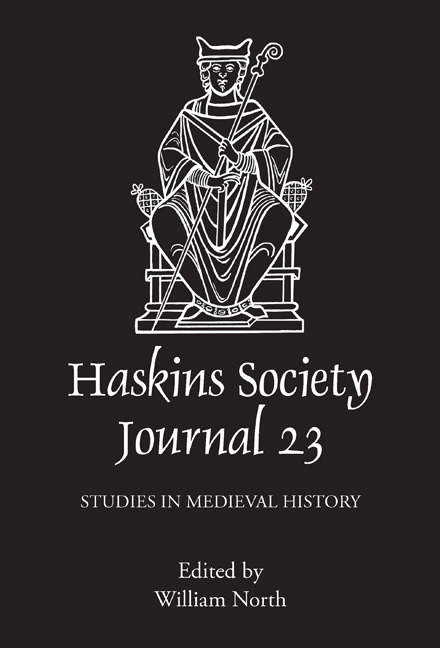Book contents
- Frontmatter
- Contents
- List of Figures
- Editor's Note
- Abbreviations
- 1 Francia and the History of Medieval Europe
- 2 Royal Control and the Disposition of Estates in Tenth-Century England: Reflections on the Charters of King Eadwig (955–959)
- 3 Denis Bethell Prize Essay: Frutolf of Michelsberg's Chronicle, the Schools of Bamberg, and the Transmission of Imperial Polemic
- 4 Manipulating Historical Memory: Cosmas on the Sees of Prague and Olomouc
- 5 Poetry and History: Baudry of Bourgueil, the Architecture of Chivalry, and the First Crusade
- Authors' Preface to Chapters 6 and 7
- 6 Men and Masculinities at the Courts of the Anglo-Norman Kings in the Ecclesiastical History of Orderic Vitalis
- 7 Men and Masculinities in William of Malmesbury's presentation of the Anglo-Norman Court
- 8 The Personnel of Comital Administration in Greater Anjou, 1129–1151
- 9 The Murder of Gilbert the Forester
- 10 The Object as Subject in Medieval Art
4 - Manipulating Historical Memory: Cosmas on the Sees of Prague and Olomouc
Published online by Cambridge University Press: 05 November 2014
- Frontmatter
- Contents
- List of Figures
- Editor's Note
- Abbreviations
- 1 Francia and the History of Medieval Europe
- 2 Royal Control and the Disposition of Estates in Tenth-Century England: Reflections on the Charters of King Eadwig (955–959)
- 3 Denis Bethell Prize Essay: Frutolf of Michelsberg's Chronicle, the Schools of Bamberg, and the Transmission of Imperial Polemic
- 4 Manipulating Historical Memory: Cosmas on the Sees of Prague and Olomouc
- 5 Poetry and History: Baudry of Bourgueil, the Architecture of Chivalry, and the First Crusade
- Authors' Preface to Chapters 6 and 7
- 6 Men and Masculinities at the Courts of the Anglo-Norman Kings in the Ecclesiastical History of Orderic Vitalis
- 7 Men and Masculinities in William of Malmesbury's presentation of the Anglo-Norman Court
- 8 The Personnel of Comital Administration in Greater Anjou, 1129–1151
- 9 The Murder of Gilbert the Forester
- 10 The Object as Subject in Medieval Art
Summary
This article considers the history of the bishopric of Prague as described in the Chronicle of the Czechs. Written c. 1120 by Cosmas, the eighty-year-old dean of Prague's cathedral, the Chronica Boemorum is an ambitious work, first treating a Czech legendary age and then the period from 894 to 1125. It is a long, complicated text that serves a number of distinct authorial agendas. First and foremost, Cosmas uses his historical narrative to offer a stinging critique of contemporary Czech politics, as well as of political power per se. But embedded within this main narrative, virtually unmarked, is also a history of the see of Prague, Cosmas's own institutional home. This essay explores the nature and significance of the intersection in the chronicle of two separate historical events, those most significant to the see: its original foundation in the second half of the tenth century and the contested division of the diocese a hundred years later to accommodate an independent bishopric in Moravia, centered at Olomouc. Regarding the dispute over Moravia (1073–91), which coincided with the most intensely fought phase of the Investiture Contest (1075–1122), Cosmas took a patently partisan stand, one that demanded a selective presentation of the recent past as well as a subtle reinterpretation of the see's establishment in the more distant past. Moreover, as waged by Bishop Jaromír/Gebhard of Prague, the dispute itself hinged on demonstrating claims about the past, specifically the circumstances of the see's original foundation.
- Type
- Chapter
- Information
- The Haskins Society Journal 232011. Studies in Medieval History, pp. 71 - 86Publisher: Boydell & BrewerPrint publication year: 2014



